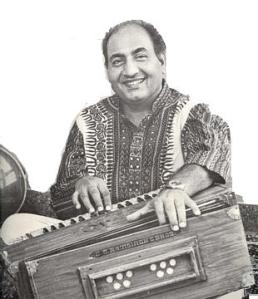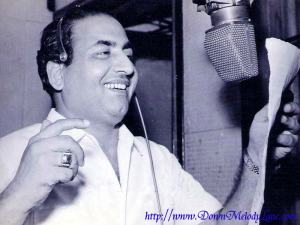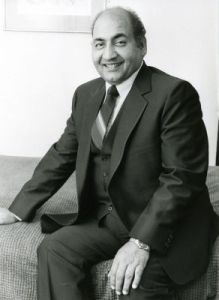For the uninitiated, Mohd. Rafi, also popularly known as Rafi Sahab to his contemporaries and fans alike, was a legendary singer who is mainly known for his work as a playback singer in Hindi films. He was the leading male playback singer in Hindi Film Industry for most part of his career spanning roughly 35 years from mid-40s till 1980. Today, more than 35 years after he passed away, he is still remembered as a legend, with his songs, style and voice still being popular among people who ha ve even the slightest exposure to music of that era. He established himself as a singer-par-excellence and reigned over Bollywood music for decades. He was not only an excellent singer but also a very humble and down-to-earth human being which is a rare thing to see among people who reach the pinnacle of success. What makes him distinct among the long list of singing artists, who existed then, exist now and probably will exist in future, was his rich tonal voice, wide vocal range, clear intonation and pronunciation, and versatility to render any kind of song with perfection. This article discusses these qualities in detail as per my understanding and analysis of his songs over the years. Some of the anecdotes and observations described here have been taken from TV/radio programmes and interviews of various persons that I had come across.
ve even the slightest exposure to music of that era. He established himself as a singer-par-excellence and reigned over Bollywood music for decades. He was not only an excellent singer but also a very humble and down-to-earth human being which is a rare thing to see among people who reach the pinnacle of success. What makes him distinct among the long list of singing artists, who existed then, exist now and probably will exist in future, was his rich tonal voice, wide vocal range, clear intonation and pronunciation, and versatility to render any kind of song with perfection. This article discusses these qualities in detail as per my understanding and analysis of his songs over the years. Some of the anecdotes and observations described here have been taken from TV/radio programmes and interviews of various persons that I had come across.
To begin with, there are many qualities that are required to be a successful singer: the absolute necessity is the ability to produce the required sequence of notes vocally (sur mein gaana). This quality is mostly a talent which one has to be gifted with and although it can be improved through training, there would be rare examples of people who have acquired this ability just through vocal training or practice. In this aspect Rafi was truly god-gifted; but so were many others. Then what was it that made him stand out? The answer to this question lies in various characteristics that he possessed: voice quality, range, versatility, soulful rendition being the few which I could put a name to. The most important and prominent one among these can be considered his “voice quality”. Given that not all vocal characteristics can be defined concretely, its difficult to put it into words but those who have listened to his songs can understand that he had a soothing, mellifluous and sweet voice. An absolute treat for the ears! Famous producer-director Manmohan Desai, who used him for many of his films, even went on to say that “Rafi Sahab ki aawaaz khuda ki aawaaz hai” (Mohd. Rafi’s voice is God’s voice). I am pretty sure that if there would have been a way to quantify voice quality, his voice would come out to be among the top ones in the entire country. Definitely, this characteristic was also a God’s gift.
Vocal range was another aspect in singing where he excelled. In simple terms, vocal range is the difference in lowest and the highest pitch that can be produced by a person vocally. Usually, a person’s voice becomes shrill and the voice quality deteriorates while singing at high pitches; but not for Rafi. He could effortlessly transition from middle octaves to higher ones without any apparent loss of tone or deterioration in voice quality. Although there are lots of his songs that demonstrate this quality, two songs that instantly come to mind with such characteristics are:
- The classic O Duniya Ke Rakhwale from Baiju Bawra, whose songs put Rafi into the list of star singers: the pitch becomes higher and higher within each stanza with Rafi Sahab traversing effortlessly through the high and low notes throughout the verses before ending the song at a very high pitch (A4, for music theory enthusiasts).
- Aye Mohabbat Zindabad from Mughal-E-Azam: in the last stanza, Mohd. Rafi quickly jumps from ‘Jiske Dil Mein Pyar Na Ho’ at medium pitch to high-pitched ‘Wo Pathar Hai’ to even higher ‘Insaan Kahan’ and as easily comes back to the middle octave in the next line.
I am not claiming he had the widest range of all singers but it was this ability that distinguished him from others.
Having talked about the above mentioned qualities, can we say that Mohd. Rafi’s singing was entirely God-gifted? Most probably not. The other aspects that he incorporated in his singing were mostly a result of vocal training, hard work (riyaz) and improvisation. One such aspect due to which he ruled the Bollywood music in 50s and 60s was his versatility. He could adapt his singing for all moods, emotions and situations. Be it the peppy numbers like Ye Chand Sa Roshan Chehra or Chahe Koi Mujhe Junglee Kahe; romantic ones like Baharon Phool Barsao or Chaudhvin Ka Chand Ho; the sad songs where the on-screen character is completely devastated like Yeh Duniya Yeh Mehfil, Kya Hua Tera Waada, Teri Galiyon Mein; ghazals such as Tumhari Zulf Ke Saaye Mein, Teri Ankhon Ke Siva; qawwalis like Parda Hai Parda and Hum Kisi Se Kam Nahin; bhajans e.g. Sukh Ke Sab Saathi, Tune Mujhe Bulaya Sherawaliye; philosphical songs such as Raahi Manwa Dukh Ki Chinta, Man Re Tu Kahe Na Dheer Dhare; classical songs such as Man Tarpat Hari Darshan Ko Aaj (also a bhajan); or comic and funny songs like Sar jo Tera Chakraye, Hum Kaale Hain To Kya Hua; Rafi had it all. Name any mood or situation and I guarantee that there would be a Rafi song for that situation. This ability to sing with perfection for any type of mood made him the first choice for any song for music directors of that time. Please bear in mind that not everyone is equipped with this kind of ability. The other leading male singers of that era such as Mukesh and Kishore Kumar, although great singers, did not have such a comprehensive catalogue of songs in different moods. For example, Mukesh was mostly confined to melancholic and romantic songs and has sung very few happy/comic/peppy songs. Kishore Kumar, on the other hand, could sing happy/romantic/peppy mood songs equally well but since he didn’t have any training in classical music, he was not adept at singing classical/semi-classical songs and qawwalis.
Hua Tera Waada, Teri Galiyon Mein; ghazals such as Tumhari Zulf Ke Saaye Mein, Teri Ankhon Ke Siva; qawwalis like Parda Hai Parda and Hum Kisi Se Kam Nahin; bhajans e.g. Sukh Ke Sab Saathi, Tune Mujhe Bulaya Sherawaliye; philosphical songs such as Raahi Manwa Dukh Ki Chinta, Man Re Tu Kahe Na Dheer Dhare; classical songs such as Man Tarpat Hari Darshan Ko Aaj (also a bhajan); or comic and funny songs like Sar jo Tera Chakraye, Hum Kaale Hain To Kya Hua; Rafi had it all. Name any mood or situation and I guarantee that there would be a Rafi song for that situation. This ability to sing with perfection for any type of mood made him the first choice for any song for music directors of that time. Please bear in mind that not everyone is equipped with this kind of ability. The other leading male singers of that era such as Mukesh and Kishore Kumar, although great singers, did not have such a comprehensive catalogue of songs in different moods. For example, Mukesh was mostly confined to melancholic and romantic songs and has sung very few happy/comic/peppy songs. Kishore Kumar, on the other hand, could sing happy/romantic/peppy mood songs equally well but since he didn’t have any training in classical music, he was not adept at singing classical/semi-classical songs and qawwalis.
As noted earlier, singing (especially playback singing) is much more than producing a sequence of notes vocally. It involves understanding the lyrics and rendering them with the feelings and expressions needed. Rafi Sahab was a master at this art. Every word in each of his songs seem to be immersed in the right amount of expressions needed for the lyrics and situation. Take for example the song Din Dhal Jaaye from the film Guide. It doesn’t seem that he is singing the song but instead describing it, as a person would have in a normal conversation. The word ‘Haaye’ in ‘Din Dhal Jaaye Haaye’ has a feeling of pain attached to it. Also, in the line ‘Aise mein kisko kaun manaye‘ in one of the stanzas, the ‘Kaun‘ here is stressed and streched more than a normal ‘Kaun‘; as if it were being said during a conversation: ‘Aise mein kisko Kaun Manaye?’. These were just a few examples of rendering of words in a song but if someone were to take renditions of songs as a whole, there also Rafi Sahab was spot-on. Just to give a few examples, listen to the pain that he brings to his voice in songs like Rang aur Noor Ki Baarat, Aaj Purani Rahon Se, the energy and charisma in Mast Baharon Ka Main Aashiq, Badan Pe Sitare etc., and the sincerity when he sings Kar Chale Hum Fida Jaan-o-Tan Saathiyon. He managed to bring perfection to every song he sang. Moreover, it was Rafi’s ability to mould his voice slightly according to the actor on which the song was to be picturized that truly defined playback singing — where you are not singing for yourself but for someone else. In a Television programme, Javed Akhtar mentioned that the two Bollywood singers who truly captured the essence of playback singing by adapting their style according to the on-screen artist were Rafi and Lata.
There is an incident about Mohd. Rafi narrated by the Late Shammi Kapoor himself. It goes like this: Rafi was the default choice for playback for Shammi Kapoor songs as he could perfectly capture the lively adaayen to be enacted by Shammi Kapoor as expressions in the song. Shammi Kapoor used to tell him before the recording of each song how he is thinking of acting/dancing in a particular part of the song and hence it had to be sung accordingly. However, during recording of oneof the songs, Shammi Kapoor was not in Mumbai but the song had to be recorded. Rafi did it by his own improvisation. Later, when Shammi Kapoor returned to Mumbai and listened to the recording, he said to Rafi Sahab: “I was not present with you at the time this song was recorded, I didn’t tell you how I was expecting certain parts in this song but the way it has been sung by you is exactly the way I would have wanted. How did you do that?”. Rafi replied in his Punjabi style: “Oye Paape! Maine yeh socheya ke Shammi Kapoor is gaane par kaise dance karega. Ek haath idhar marega, ek taang udhar phenkega! Bas yahi soch ke maine gaa diya!” (I just thought how would Shammi Kapoor dance on this song. He would be throwing his arms and legs around at various points in the song! I kept that in mind and sang accordingly!). This song was the popular Aasman Se Aaya Farishta from the movie An Evening in Paris. Listen to this song carefully to realize the improvisation level of this man.
So was it all too easy for this man to come and pick-up any tune? No. Some music director was quoted in an article saying that sometimes he had difficulties in picking up a tune instantly, but he used to rehearse the song in the studio as well as at his home. On the day of recording, he used to be perfect. This implies that no matter how much talented a person is, hard work is nevertheless required to achieve success.
Despite achieving so much of success in the music industry, Mohd. Rafi remained a humble human being without the slightest hint of arrogance. It has been mentioned many times by his son Shahid Rafi that whenever someone used to praise him during or after a recording, he used to shake his hand and point his finger upwards towards the sky — a gesture to indicate that whatever talent he had was gifted by God. He also used to help new music directors and film producers who were low on budget by singing songs for them free or at a nominal charge like Re 1.
Mohd. Rafi sang around 4500 Hindi Film songs, close to 350 regional film songs and around 130 Non-film hindi songs according to Wikipedia. He died aged 55 on 31st July 1980 due to a heart attack. His untimely death left a huge void in the Bolloywood music industry. In fact, after he passed away, the industry saw a number of male singers such as Mohd. Aziz, Shabbir Kumar and Anwar trying to mimic Rafi’s voice and style in songs for many years. This was a result of the void left by Rafi and the longing of the public to listen to more of his style. Even an entire song was created in his honour as a tribute in the 1990 film Krodh called ‘Na Fankaar Tujhsa Tere Baad Aaya, Mohd. Rafi Tu Bahut Yaad Aaya‘, sung by Mohd. Aziz and picturized on Amitabh Bachhan singing in a stage programme.
Leading singers like Sonu Nigam, Udit Narayan, Javed Ali consider Rafi as their idol. In fact, Sonu Nigam started his career by singing covers of Rafi songs in the early 90s. He has mentioned in interviews that he considers Rafi as his musical father and has listened to him very carefully over the years and learnt a lot of things about playback singing. Udit Narayan has said that he had the privilege to record his first-ever song in Bollywood with Rafi Sahab, to whom he grew up listening to on radio. Not only for singers, he remains an inspiration for millions of his fans around the world till today. His songs remain as popular even 35 years after his death as they would be during his lifetime. Many of his songs have become classics that are associated with various ceremonies in people’s lives. Baharon Phool Barsao has become an integral part of every Indian wedding ceremony, as has Aaj Mere Yaar Ki Shaadi Hai for baaraats, and the emotional Babul Ki Duayen Leti Jaa for bidaai. Govinda Aala Re has become a symbol of Janmashtami and Matki Phod ceremonies over the years. He may have departed from this world but I am sure his work and his voice will continue to enthral music lovers for decades to come.

